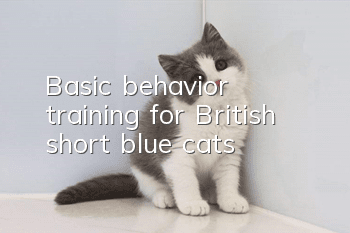What kind of special litter box should be prepared for pet cats?

When you are preparing to bring a cat or kitten into your home, make sure you have all the things you need to make your new pet feel at home. In addition to providing high-quality food, a safe environment, proper veterinary services, and lots of love, it's also important to consider your cat's litter box. While it may not seem like a very important subject at first, the litter box will quickly become a focus of your attention should your cat decide to stop using it. Removing barriers is one of the biggest reasons cats are abandoned at shelters, and one of the most common issues for people seeking veterinary advice is.
While it is true that most cats will instinctively use a litter box when they are young kittens, some basic knowledge about cat litter boxes can help prevent problems from starting in the first place. And, as we all know, it’s easier to prevent a problem after it starts than to deal with it! Here are some points to keep in mind:
New kittens
Cats have a natural instinct to eliminate in sand or mud, and kittens also learn from watching their mothers. Kittens usually start learning to use a litter box at 3 or 4 weeks of age, so by the time you bring your kitten home, she will likely be used to using a litter box.
You won't need to train your kitten to use that little box, you'll be house-breaking a puppy. However, it is important to make sure your kitten knows where the litter box is in her new environment. Make sure the box is not in a noisy or hard-to-reach location. Soon after you bring your kitten home, take her to the litter box for a quiet time. Put her in the litter box, gently nudge her front paws, and show her how to scratch once or twice in the litter. Don't worry if she jumps right out again. She is placed in the box at times throughout the day, when a cat usually goes to the bathroom: first thing in the morning, after meals, naps and wakes up from a nap. Remember, cats like privacy when using the litter box, so once you see her being used, leave her alone.
Most cats will make the adjustment to a new small box without any problems. However, if something unexpected happens, don't scold or punish your cat. Yelling, or using a spray bottle will only confuse and scare your cat away, and she won't understand why you're upset. Instead, clean up accidents with enzymatic cleaners to remove stains and odors. Then go back to square one and put the kitten in the litter box frequently until she starts using it. If the incident continues, or if you notice any diarrhea or nervousness, have your kitten reviewed by your veterinarian to rule out any possible medical issues. Cats with urinary tract disease or intestinal parasites may stop using the litter box.
Number of boxes
The rule of thumb here is that you should provide one cat per litter, plus one extra. Although this may seem a bit redundant to usCats are very picky, and some cats will not use a litter box that other cats have already used. Some cats also like to use one box to urinate and another to defecate. If your home has several levels, make sure there are dumpsters on each floor.
Location
Cat's Little Box in a Quiet, Private Corner Cats love to use that little box, a quiet, private place where they feel safe. Loud noises, people walking in and out, or another challenge from a startled dog or cat as they leave the litter box (such as the buzzer on the washer and dryer) can be alarming enough to make your The cat chooses another location.
If your dog tries to steal treats from the cat's litter box, try to place a baby gate across from the window and in the room where the litter box is (this will also work over a closet door if needed). Place the door a few inches off the ground so cats can get under it but dogs can't. In addition to preventing the dog from harassing the cat as she enters or leaves the restricted area, this will prevent your dog from developing intestinal obstruction by eating cat litter, or becoming infected with any intestinal worms that the cat may have the chance to do. If your dog is small enough to get under the door, position the bottom of the door on the floor and place one in front of the door to help the cat jump up.
If you have more than one cat, make sure the small box is not in a location where one cat can 'corner' another as she exits the toilet (for example, in a dead-end hallway). There is always an entrance and an exit for everything. Most cats don't like having a food dish next to their litter box, so avoid this.
Size and bin style
There are many types of litter boxes available, including covered bins, self-cleaning bins, and corner tow bins designed to fit. Please make sure the litter box you provide is the appropriate size(s) for your cat(s). Some animal behavior says that the litter boxes people provide are often too small. Keep in mind that kittens or older cats may need a box on the underside. If you need a large box with relatively low sides, consider a sweater storage box. You can also cut the sides of the sweater box if desired. Some cats may feel safer in a litter box with a hood. This can also be helpful for cats who dig very enthusiastically because they cover things up. This can also work well for cats who stand on the edge of a restricted area to relieve themselves. However, a mask box can concentrate odors and should be cleaned daily. New fully automatic self-cleaning bins can save time cleaning up, but some models are noisy. Some cats seem to be bothered by noise, and some are clearly not. If you have several cats, you may want to provide several types of litter boxes and let your cats choose between them.
Litter type
Generally speaking, cats look likeTrash, with the consistency of beach or garden soil. They seem to prefer fine textured litter (like clumping type) to coarser litter, and traceless litter to scented litter. Two-inch bins of litter are usually adequate. It usually works better to use less junk and change it more often. If you're not sure what type of litter to use, put several types of litter in, including aggregated and non-aggregated, and watch what your cat likes.
Cleanliness
Cats are very clean animals and they may avoid cleaning a small box often enough. Hit the trash can at least once a day. Clean the litter box and change the bedding completely once a week. Do not use strong-smelling disinfectants on the box, but it is good to rinse the box after cleaning. Any accidents should be cleaned with an enzymatic cleaner made specifically for pet stains, including cat urine. Regular cleaners may mask the odor so that we can't smell it, but with cats' superior sense of smell, the odor will still be noticeable and encourage the cat to continue using the area as a bathroom.
- Will Ragdoll cats’ fur become darker in winter?
- Why do cats eat dead leaves?
- Is it good to neuter male cats?
- Is it okay for cats to eat one kind of cat food for a long time?
- Will impure folded-eared cats get sick?
- Do cats cry after being abandoned?
- Symptoms and treatments for spontaneous cystitis in cats
- Can hair in a cat's eye come out on its own?
- How to change a timid cat?
- The cat's cheek is swollen



